Reading time: 11 min
In the old times, when it was still of some use to wish for the thing one wanted, there lived a King whose daughters were all handsome, but the youngest was so beautiful that the sun himself, who has seen so much, wondered each time he shone over her because of her beauty. Near the royal castle there was a great dark wood, and in the wood under an old linden-tree was a well. And when the day was hot, the King’s daughter used to go forth into the wood and sit by the brink of the cool well, and if the time seemed long, she would take out a golden ball, and throw it up and catch it again, and this was her favourite pastime.
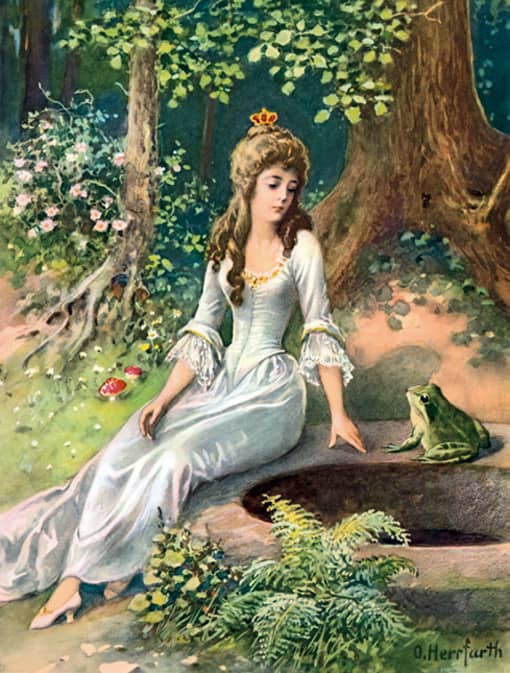 Image: Oskar Herrfurth (1862-1934)
Image: Oskar Herrfurth (1862-1934)Now it happened one day that the golden ball, instead of falling back into the maiden’s little hand which had sent it aloft, dropped to the ground near the edge of the well and rolled in. The king’s daughter followed it with her eyes as it sank, but the well was deep, so deep that the bottom could not be seen. Then she began to weep, and she wept and wept as if she could never be comforted. And in the midst of her weeping she heard a voice saying to her: „What ails thee, king’s daughter? Thy tears would melt a heart of stone.“ And when she looked to see where the voice came from, there was nothing but a frog stretching his thick ugly head out of the water.
„Oh, is it you, old waddler?“ said she, „I weep because my golden ball has fallen into the well.“ – „Never mind, do not weep,“ answered the frog, „I can help you; but what will you give me if I fetch up your ball again?“ – „Whatever you like, dear frog,“ said she, „any of my clothes, my pearls and jewels, or even the golden crown that I wear.“ – „Thy clothes, thy pearls and jewels, and thy golden crown are not for me,“ answered the frog, „but if thou wouldst love me, and have me for thy companion and play-fellow, and let me sit by thee at table, and eat from thy plate, and drink from thy cup, and sleep in thy little bed, if thou wouldst promise all this, then would I dive below the water and fetch thee thy golden ball again.“
„Oh yes,“ she answered, „I will promise it all, whatever you want, if you will only get me my ball again.“ But she thought to herself: What nonsense he talks! As if he could do anything but sit in the water and croak with the other frogs, or could possibly be any one’s companion. But the frog, as soon as he heard her promise, drew his head under the water and sank down out of sight, but after a while he came to the surface again with the ball in his mouth, and he threw it on the grass. The King’s daughter was overjoyed to see her pretty plaything again, and she caught it up and ran off with it. „Stop, stop!“ cried the frog, „take me up too.
I cannot run as fast as you!“ But it was of no use, for croak, croak after her as he might, she would not listen to him, but made haste home, and very soon forgot all about the poor frog, who had to betake himself to his well again. The next day, when the King’s daughter was sitting at table with the King and all the court, and eating from her golden plate, there came something pitter patter up the marble stairs, and then there came a knocking at the door, and a voice crying: „Youngest King’s daughter, let me in!“ And she got up and ran to see who it could be, but when she opened the door, there was the frog sitting outside. Then she shut the door hastily and went back to her seat, feeling very uneasy.
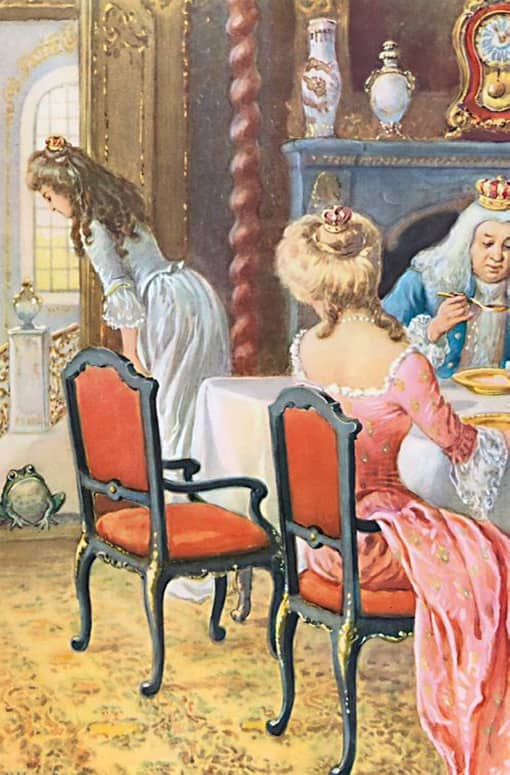 Image: Oskar Herrfurth (1862-1934)
Image: Oskar Herrfurth (1862-1934)The King noticed how quickly her heart was beating, and said: „My child, what are you afraid of? Is there a giant standing at the door ready to carry you away?“ – „Oh no,“ answered she, „no giant, but a horrid frog.“ – „And what does the frog want?“ asked the King. „O dear father,“ answered she, „when I was sitting by the well yesterday, and playing with my golden ball, it fell into the water, and while I was crying for the loss of it, the frog came and got it again for me on condition I would let him be my companion, but I never thought that he could leave the water and come after me; but now there he is outside the door, and he wants to come in to me.“ And then they all heard him knocking the second time and crying:
„Youngest King’s daughter.
Open to me!
By the well water.
What promised you me?
Youngest King’s daughter.
Now open to me!“
„That which thou hast promised must thou perform,“ said the King, „so go now and let him in.“ So she went and opened the door, and the frog hopped in, following at her heels, till she reached her chair. Then he stopped and cried: „Lift me up to sit by you.“ But she delayed doing so until the King ordered her. When once the frog was on the chair, he wanted to get on the table, and there he sat and said: „Now push your golden plate a little nearer, so that we may eat together.“ And so she did, but everybody might see how unwilling she was, and the frog feasted heartily, but every morsel seemed to stick in her throat. „I have had enough now,“ said the frog at last, „and as I am tired, you must carry me to your room, and make ready your silken bed, and we will lie down and go to sleep.“
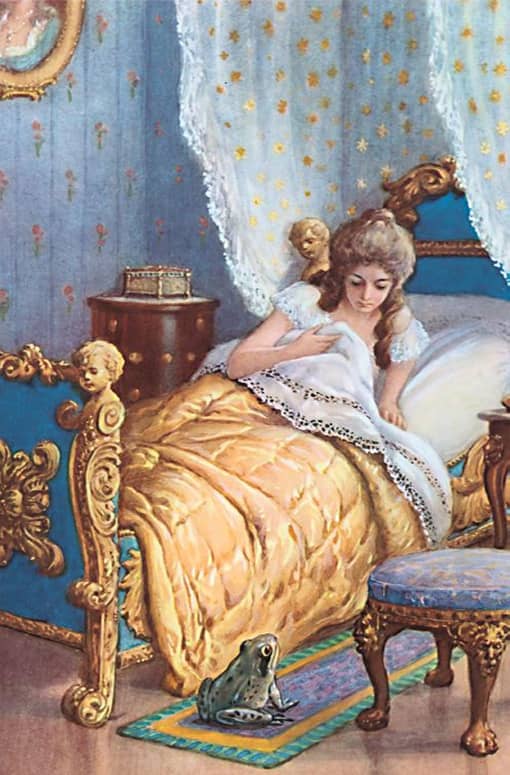 Image: Oskar Herrfurth (1862-1934)
Image: Oskar Herrfurth (1862-1934)Then the King’s daughter began to weep, and was afraid of the cold frog, that nothing would satisfy him but he must sleep in her pretty clean bed. Now the King grew angry with her, saying: „That which thou hast promised in thy time of necessity, must thou now perform.“ So she picked up the frog with her finger and thumb, carried him upstairs and put him in a corner, and when she had lain down to sleep, he came creeping up, saying: „I am tired and want sleep as much as you. Take me up, or I will tell your father.“ Then she felt beside herself with rage, and picking him up, she threw him with all her strength against the wall, crying: „Now will you be quiet, you horrid frog!“
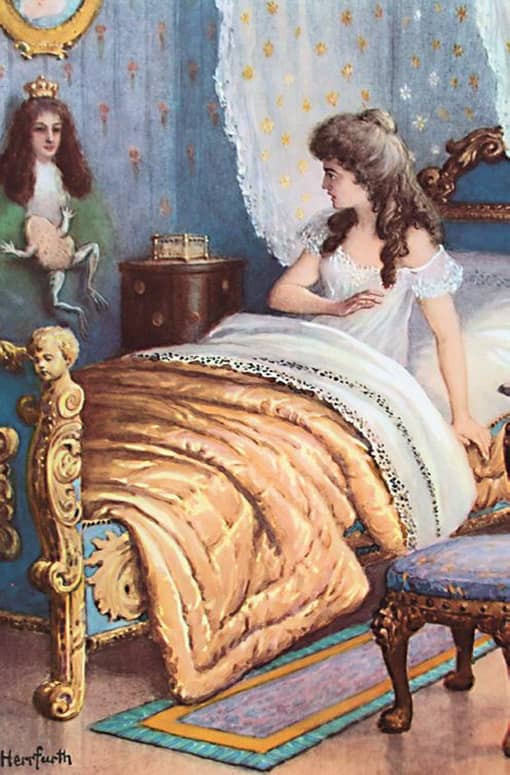 Image: Oskar Herrfurth (1862-1934)
Image: Oskar Herrfurth (1862-1934)But as he fell, he ceased to be a frog, and became all at once a prince with beautiful kind eyes. And it came to pass that, with her father’s consent, they became bride and bridegroom. And he told her how a wicked witch had bound him by her spells, and how no one but she alone could have released him, and that they two would go together to his father’s kingdom. And there came to the door a carriage drawn by eight white horses, with white plumes on their heads, and with golden harness, and behind the carriage was standing faithful Henry, the servant of the young prince.
Now, faithful Henry had suffered such care and pain when his master was turned into a frog, that he had been obliged to wear three iron bands over his heart, to keep it from breaking with trouble and anxiety. When the carriage started to take the prince to his kingdom, and faithful Henry had helped them both in, he got up behind, and was full of joy at his master’s deliverance. And when they had gone a part of the way, the prince heard a sound at the back of the carriage, as if something had broken, and he turned round and cried:
„Henry, the wheel must be breaking!
The wheel does not break.
Tis the band round my heart.
That, to lessen its ache.
When I grieved for your sake.
I bound round my heart.“
Again, and yet once again there was the same sound, and the prince thought it must be the wheel breaking, but it was the breaking of the other bands from faithful Henry’s heart, because it was now so relieved and happy.
 Learn languages. Double-tap on a word.Learn languages in context with Childstories.org and Deepl.com.
Learn languages. Double-tap on a word.Learn languages in context with Childstories.org and Deepl.com.Backgrounds
Interpretations
Adaptions
Summary
Abstract
Linguistics
„The Frog King or Iron Heinrich,“ also known as „The Frog Prince,“ is a well-known fairy tale collected by the Brothers Grimm in their „Children’s and Household Tales.“ The story is classified under the Aarne-Thompson-Uther (ATU) folktale classification system as ATU 440 – The Frog King. The tale has roots in European folklore, with versions dating back to the Middle Ages.
The Brothers Grimm were German scholars, linguists, and authors who are best known for their collection of fairy tales, which aimed to preserve traditional oral stories passed down through generations. Their work has had a profound influence on Western literature and folklore, with their collected tales becoming some of the most well-known and beloved stories worldwide. The story of „The Frog Prince“ has roots in European folktales and has inspired many adaptations, variations, and retellings throughout the years. The central theme of the story, the transformation of a cursed individual (often royalty) through the power of love or a selfless act, has become a recurring motif in many other fairy tales and literary works.
Some of the key elements in the story, such as the golden ball and the well, are also found in other European folktales. In some versions of the story, the princess’s act of throwing the frog against the wall is replaced by a kiss or other acts of kindness, emphasizing the transformative power of love and kindness. The character of Iron Heinrich adds another layer of meaning to the story, representing loyalty and devotion, and showing the impact that the prince’s curse had on those who cared for him.
The story follows a young princess who accidentally drops her golden ball into a pond. A talking frog offers to retrieve the ball in exchange for the princess’s friendship and a promise to let him live with her in the castle. Reluctantly, the princess agrees, but she breaks her promise as soon as she gets her ball back. However, the frog follows her to the castle, and her father, the king, insists that she must honor her promise. In the Brothers Grimm version, the princess is initially repulsed by the frog and throws him against a wall in disgust. This action breaks the spell, and the frog turns into a handsome prince who had been cursed by a witch. The two fall in love and marry, and the prince’s loyal servant, Iron Heinrich, rejoices as the prince’s happiness causes the iron bands around his heart to break. In other versions, the spell is broken when the princess kisses the frog or lets him sleep on her pillow.
The tale of „The Frog Prince“ explores themes of transformation, love, the importance of keeping promises, and the power of true friendship. It has inspired numerous adaptations and retellings across various forms of media, making it one of the most well-known and enduring fairy tales in the genre.
„The Frog Prince“ offers various interpretations and themes, as it explores human values, moral lessons, and transformation. Some key themes and interpretations of the story include.
Transformation and growth: The story of the frog transforming into a prince is a metaphor for personal growth and development. The frog’s transformation can be seen as a symbol of the potential for change within oneself or others, and the power of love and kindness to bring about that change. The story illustrates the transformation of both the frog prince and the princess. The frog prince is literally transformed from a frog back into a human, while the princess undergoes an emotional transformation as she learns to keep her promises and accept the frog as her companion. This can be seen as a metaphor for the personal growth and change that people undergo throughout their lives.
Keeping promises: The tale emphasizes the importance of keeping one’s promises. The princess initially breaks her promise to the frog, but her father, the king, insists that she must honor her commitment. This teaches readers the value of integrity and the significance of staying true to one’s word. The importance of keeping one’s word is emphasized in the story. The princess initially tries to avoid her promise to the frog, but her father, the king, insists that she must honor her commitment. This teaches the lesson that promises should be kept, even when it might be difficult or unpleasant to do so.
The power of love: Love plays a crucial role in breaking the witch’s spell on the frog prince. The princess’s actions, though initially born out of frustration, ultimately lead to the prince’s transformation. This demonstrates the power of love to overcome obstacles and bring about positive change.
Appearances can be deceiving: The story serves as a reminder that appearances can be deceiving and that one should not judge others based solely on their outward appearance. The frog, initially seen as ugly and repulsive, turns out to be a kind and gentle prince.
Loyalty and friendship: The character of Faithful Henry represents unwavering loyalty and friendship. He suffers greatly while his master is under the spell and wears iron bands around his heart to keep it from breaking. This highlights the value of true friendship and loyalty in the face of adversity. The princess’s initial reluctance to befriend the frog highlights the importance of looking beyond appearances and recognizing the value of true friendship. As the story unfolds, the princess learns to appreciate the frog’s kindness and loyalty, eventually leading to their mutual love and the breaking of the curse.
Overcoming prejudice: The story also explores the theme of overcoming prejudice and preconceived notions. The princess initially judges the frog based on his appearance and is repulsed by him. However, she eventually learns to see past his exterior and recognize his true worth, leading to the breaking of the curse and the frog’s transformation into a prince.
Loyalty and devotion: Iron Heinrich, the prince’s loyal servant, exemplifies loyalty and devotion throughout the story. His heart is bound by iron bands due to his deep sorrow when the prince was cursed. When the prince finally finds happiness, Heinrich’s iron bands break, symbolizing the power of unwavering loyalty and the significance of true friendship.
„The Frog Prince“ presents readers with a tale that explores human values, transformation, and the power of love and friendship. Its themes continue to resonate with audiences and offer valuable lessons about integrity, loyalty, and the importance of looking beyond appearances. In summary, „The Frog Prince“ can be interpreted as a story about transformation, personal growth, the importance of keeping promises, the power of love, the dangers of judging others by their appearance, and the significance of loyalty and friendship.
„The Frog King or Iron Heinrich,“ also known as „The Frog Prince,“ is a German fairy tale collected by the Brothers Grimm, Jacob and Wilhelm Grimm, in their collection „Grimm’s Fairy Tales“ (or „Kinder- und Hausmärchen“), first published in 1812. The tale is classified as Aarne-Thompson-Uther (ATU) type 440, which is a category of stories involving the transformation of an animal into a human, usually through an act of love or a test of character. It has inspired numerous adaptations and retellings across various media:
Books and retellings: „The Frog Prince, Continued“ (1991) by Jon Scieszka and Steve Johnson: This picture book offers a humorous, modern take on the classic story, exploring what happens after the princess and the prince marry. „The Frog Princess“ (2002): This book by E.D. Baker is a retelling of the classic fairy tale with a twist. The story follows a princess named Emeralda, who is turned into a frog by an evil fairy. She must find a way to break the curse and turn back into a human. „The Frog Bride“ (1994): This book by Antonia Barber is a Russian folktale adaptation of „The Frog Prince.“ The story follows a prince who marries a frog princess, but when he disobeys her instructions, she disappears, and he must search for her.
Animated Films: „The Frog Prince“ (1986): An animated film adaptation directed by Jackson Hunsicker, featuring Aileen Quinn and John Paragon. This adaptation adds a witch character who transforms the prince into a frog. „Grimm’s Fairy Tale Classics“ (1987-1989): This Japanese animated series, known as „Grimm Masterpiece Theater“ in Japan, adapted numerous Brothers Grimm fairy tales, including „The Frog Prince.“ Disney’s „The Princess and the Frog“ (2009): This animated movie puts a spin on the classic fairy tale by setting it in New Orleans in the 1920s. The story follows Tiana, a hardworking waitress who dreams of opening her own restaurant, and a prince named Naveen, who has been turned into a frog by an evil witch doctor. When Tiana kisses the frog, she turns into a frog herself, and the two embark on a journey to reverse the curse. „The Frog Prince“ (1986): This TV movie stars John Paragon as the Frog Prince and Aileen Quinn as the princess. The story follows the classic fairy tale closely, with the frog transforming into a prince when the princess keeps her promise to him.
Stage adaptations: „The Frog Prince“ (2006) by David Mamet: This adaptation is a one-act play that reinterprets the story with a modern sensibility and a focus on the relationship between the princess and the frog. „The Princess and the Frog“ (2009) by Disney: Although not a direct adaptation, this animated film is loosely inspired by „The Frog Prince.“ Set in New Orleans, the story follows Tiana, a hardworking young woman who dreams of opening her own restaurant. When she kisses a prince-turned-frog, named Naveen, she too becomes a frog, and they embark on an adventure to break the curse and regain their human forms.
Television adaptations: „Faerie Tale Theater“ (1982-1987): This live-action anthology television series, created by Shelley Duvall, adapted various classic fairy tales, including „The Frog Prince“ in an episode featuring Robin Williams and TeriGarr. A British-German film adaptation directed by John Hough, starring Kermit the Frog as the Frog Prince. This adaptation incorporates puppetry and live-action elements, providing a unique take on the classic tale.
These are just a few examples of the many adaptations of „The Frog Prince“ from the Brothers Grimm. The story’s themes of transformation, love, and the breaking of curses continue to captivate audiences and inspire new interpretations across various forms of media.
„The Frog Prince“ is a fairy tale collected by the Brothers Grimm. The story begins with a young princess who accidentally drops her favorite golden ball into a deep well. A talking frog appears and offers to retrieve the ball for her if she promises to be his friend and take him home with her. Reluctantly, the princess agrees.
When the frog retrieves the ball, the princess takes it and runs off without fulfilling her promise. Later, the frog comes to the palace, and the king insists that his daughter must keep her word. She unhappily allows the frog to share her meal and sleep in her room. In some versions of the story, the princess angrily throws the frog against a wall, while in others, she gives him a gentle kiss. Either way, the frog magically transforms into a handsome prince who was cursed by a wicked witch.
The prince reveals that the princess’s actions have broken the curse, and they soon fall in love and marry. In some versions of the tale, the story also includes the character of Iron Heinrich, the prince’s faithful servant. When the prince was turned into a frog, Heinrich’s heart tightened with sorrow, so he placed three iron bands around his chest to prevent his heart from breaking. When the curse is lifted, Heinrich’s iron bands break apart, symbolizing the release of his heartache. The prince, the princess, and Iron Heinrich then live happily ever after.
„The Frog Prince“ is a fairy tale by the Brothers Grimm that tells the story of a beautiful princess and a frog who is actually a prince under a witch’s spell. The tale begins with the youngest princess playing with her golden ball near a well in the woods. One day, she accidentally drops the ball into the well, and a frog offers to retrieve it for her in exchange for her companionship. The princess reluctantly agrees but later tries to avoid her promise.
When the frog shows up at the castle, the king insists that his daughter honor her promise. The frog joins the princess at the dinner table and eventually requests to sleep in her bed. Frustrated, the princess throws the frog against the wall, which breaks the spell and transforms him back into a prince. With the king’s consent, the two get married and set off for the prince’s kingdom in a carriage drawn by eight white horses.
Faithful Henry, the prince’s servant, who had been heartbroken by his master’s transformation, rides behind the carriage. During the journey, the prince hears a sound that he thinks is the wheel breaking, but it’s actually the iron bands around Henry’s heart snapping in relief and happiness for his master’s deliverance. The story emphasizes the importance of keeping promises and the power of love to break even the darkest of spells.
The fairy tale „The Frog Prince“ by the Brothers Grimm is rich in linguistic features and themes, which contribute to its timeless appeal and enduring significance.
Themes and Motifs
Transformation and Redemption: The theme of transformation is central to the narrative. The frog’s metamorphosis into a prince symbolizes the idea of inner value transcending outward appearances. This motif is common in folklore, reflecting the belief in the potential for redemption and change.
Promises and Consequences: The story emphasizes the importance of keeping promises, as seen when the King’s daughter is compelled to honor her commitment to the frog. This reflects the moral lesson about the integrity and fulfillment of one’s word.
Deception and Realization: Initially, the princess deceives the frog with no intention of keeping her promise. However, her eventual compliance leads to the revelation of the frog’s true identity. This highlights the unexpected outcomes of deceit and the journey toward truth.
Love and Loyalty: The character of Faithful Henry exemplifies loyalty and devotion. His breaking heart bands symbolize the emotional burden of servitude and the relief and joy that come from fidelity and love prevailing over adversity.
Repetition: The tale uses repetition to emphasize elements and enhance its rhythmic quality. The frog’s repeated cries at the door and Henry’s refrain about his heart bands are examples that create anticipation and reinforce the story’s themes.
Dialogue: The direct speech between characters is a significant narrative device. It reveals character traits and motivations, such as the impatience of the princess and the persistence of the frog, making the story engaging and dynamic.
Imagery: Vivid imagery paints the settings and characters, enhancing the magical atmosphere. Descriptions like the “golden ball” and “eight white horses with golden harness” create a sense of wonder and enchantment.
Contrast: The contrast between the beautiful princess and the ugly frog underscores the theme of transformation. It challenges societal norms regarding appearances, encouraging readers to look beneath the surface.
Personification: The sun is personified as a witness to the princess’s beauty, lending an omniscient quality to nature and emphasizing the fairy tale setting where nature often plays an active role.
Symbolism
The Golden Ball: Symbolizes innocence, purity, and the carefree nature of youth, which the princess loses temporarily and must mature to regain.
The Well: Represents an entry into another realm or the subconscious, a common motif in fairy tales where significant events (like transformation) often occur near mystical locations like wells or forests.
The Iron Bands: Serve as a symbol of emotional restraint and the power of loyalty. Their breaking signifies liberation and the healing power of love and happiness.
Overall, the linguistic elements and themes in „The Frog Prince“ combine to create a layered narrative that explores profound human experiences through a whimsical lens. The story continues to resonate with audiences due to its moral lessons, enchanting language, and the universal human longing for transformation and redemption.
Information for scientific analysis
Fairy tale statistics | Value |
|---|---|
| Number | KHM 1 |
| Aarne-Thompson-Uther-Index | ATU Typ 440 |
| Translations | DE, EN, EL, EL, DA, ES, FR, PT, FI, HU, IT, JA, NL, KO, PL, RO, RU, TR, VI, ZH |
| Readability Index by Björnsson | 31.5 |
| Flesch-Reading-Ease Index | 81.8 |
| Flesch–Kincaid Grade-Level | 7.2 |
| Gunning Fog Index | 9.9 |
| Coleman–Liau Index | 7.2 |
| SMOG Index | 7.8 |
| Automated Readability Index | 7.8 |
| Character Count | 7.292 |
| Letter Count | 5.514 |
| Sentence Count | 65 |
| Word Count | 1.412 |
| Average Words per Sentence | 21,72 |
| Words with more than 6 letters | 138 |
| Percentage of long words | 9.8% |
| Number of Syllables | 1.719 |
| Average Syllables per Word | 1,22 |
| Words with three Syllables | 41 |
| Percentage Words with three Syllables | 2.9% |
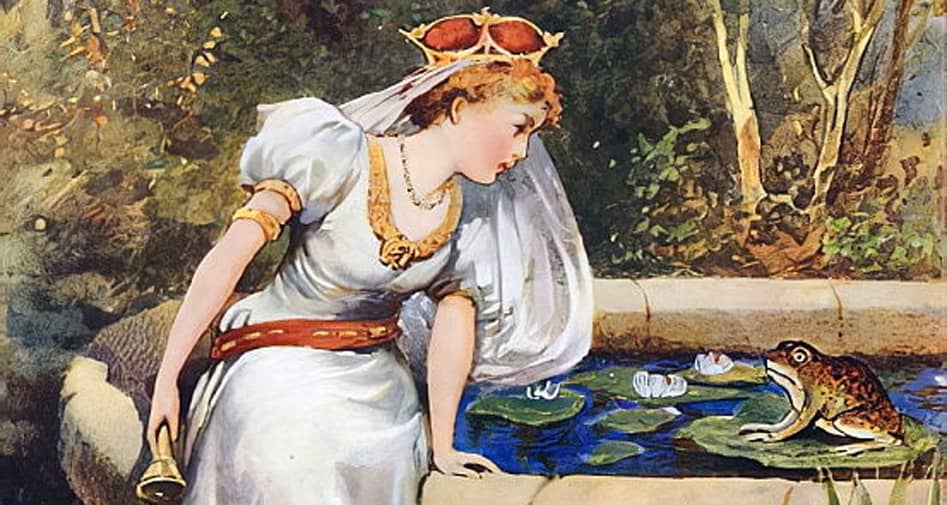
 Facebook
Facebook  Whatsapp
Whatsapp  Messenger
Messenger  Telegram
Telegram Reddit
Reddit















